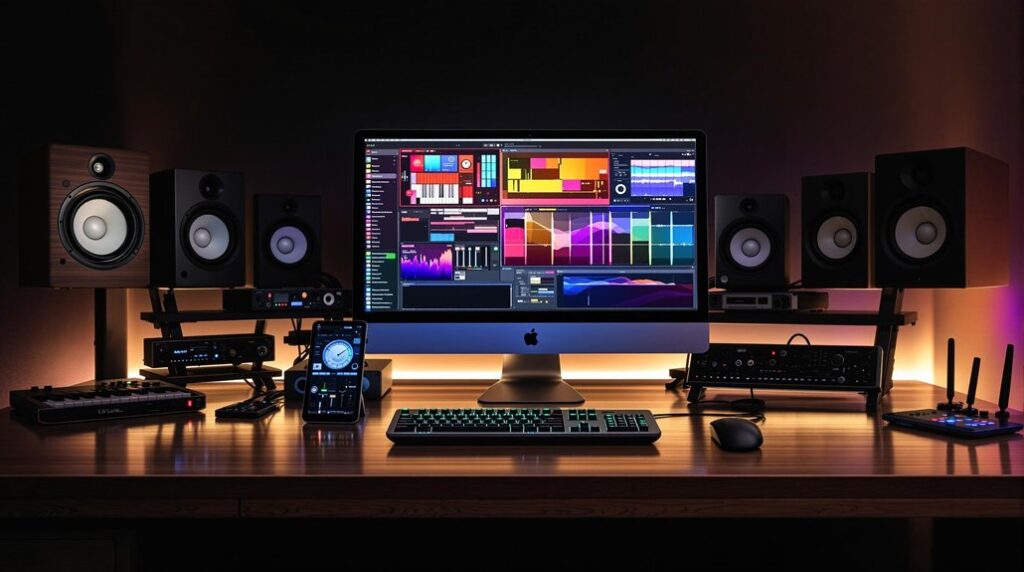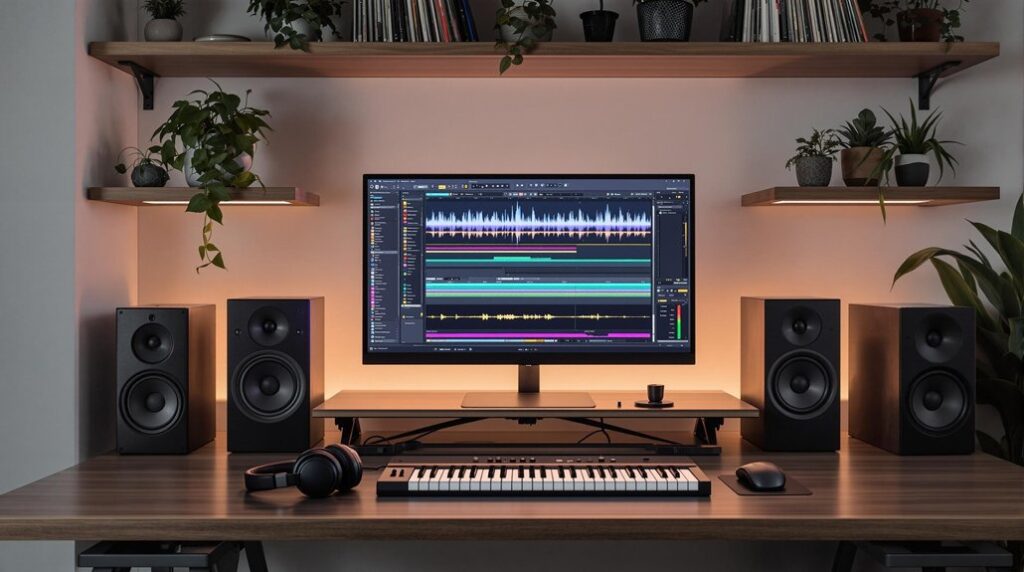To stop clipping in Ableton and achieve pristine sound, follow these steps: First, recognize the clipping by monitoring your audio levels closely. Set your peak levels between -9 and -6 dB for ideal headroom. Utilize proper gain staging across all tracks, keeping average levels around -18 dB. Manage transients with compressors and limiters to control peaks. Monitor your system’s performance to avoid bottlenecks. Always check your meters for both pre-fader and post-fader levels. Finally, review your mixes on various systems to guarantee consistency. By mastering these techniques, you’ll enhance your sound quality greatly, which will be further explored ahead.
Key Takeaways
- Set individual track peak levels between -16 dB and -12 dB to ensure headroom and prevent clipping during mixing.
- Utilize compressors and limiters to control transient peaks, adjusting parameters to maintain audio dynamics without distortion.
- Regularly monitor both pre-fader and post-fader levels to maintain balanced audio signals and identify potential clipping issues early.
- Implement surgical EQ cuts to refine mixes and reduce resonances that can contribute to clipping artifacts.
- Use true peak meters on the master bus to accurately detect inter-sample peaks and avoid exceeding 0 dB FS.
Understanding Clipping
When audio signals exceed the 0 dB FS threshold, you encounter a phenomenon known as clipping, which distorts the waveform and diminishes audio fidelity. Clipping results in harsh, unpleasant sounds that mask the subtleties of your music, degrading the overall listening experience.
Common causes of clipping include improper gain staging, excessive input levels, and inadequate level monitoring in your digital audio workstation (DAW).
Two main types exist: hard clipping, producing sharp distortions, and soft clipping, delivering a smoother sound.
To maintain ideal audio quality, you must guarantee proper gain, aiming for peak levels around -9 to -6 dB. This practice maximizes your dynamic range and helps prevent clipping, allowing for clearer, more enjoyable audio. Additionally, utilizing True Peak Meters can assist in monitoring inter-sample peaks effectively and avoiding distortion.
Identifying Clipping in Ableton
To identify clipping in Ableton, you need to watch for red metering indicators, which signal that your audio signal has surpassed 0dB FS. Regularly monitor the dynamic range across your tracks to prevent any one element from overwhelming the mix. Additionally, make it a habit to analyze output levels from plugins, as clipping may occur there even if the fader remains unaffected. Implementing audio compression can also help in managing levels and ensuring a balanced mix.
Red Metering Indicators
Red metering indicators in Ableton Live are critical visual cues that alert you to potential clipping issues in your audio tracks. When you see these indicators, it means audio levels have exceeded 0 dB FS, risking sound distortion and degrading audio quality.
To maintain proper gain and guarantee a clean mix, keep these points in mind:
- Regularly monitor individual channel meters.
- Watch the master output meter closely.
- Look for flat-topped waveforms indicating clipping.
- Analyze output levels from all plugins, as they can clip without red indicators.
- Adjust levels during the mixing process to prevent track dominance.
Monitor Dynamic Range
Monitoring dynamic range is essential for maintaining audio integrity in your Ableton projects. To effectively prevent clipping, aim for average peak levels between -16dB and -12dB on your tracks. This range helps maintain clarity while keeping your audio signal robust.
Regularly utilize true peak meters to accurately measure inter-sample peaks, as standard meters may not reveal hidden clipping. Employ dynamic processing tools like compressors and limiters to manage transients effectively; this guarantees that peaks are controlled and minimizes the risk of distortion.
Also, keep an eye on your output levels to avoid any single track dominating the mix, which can lead to loss of dynamic range and compromise your pristine audio quality.
Analyze Output Levels
Clipping can easily sneak into your mixes if you’re not vigilant about analyzing output levels in Ableton.
To effectively monitor your audio signals, focus on the following:
- Regularly check both pre-fader and post-fader levels.
- Utilize true peak meters to catch inter-sample peaks that could distort.
- Maintain average peak levels around -16dB to -12dB for adequate headroom.
- Use spectrum analyzers to visualize frequency balance.
- Employ dynamic range meters to assess track dynamics.
Proper Gain Staging Techniques
To achieve ideal gain staging, you should set your peak levels between -16 dB and -12 dB for each track, ensuring enough headroom.
Regularly monitor your signal path, checking both pre-fader and post-fader levels to maintain balance and prevent clipping.
Implement consistent level checks to adjust dynamics and leverage automation for precise control over volume, keeping all tracks below the 0 dB threshold. Additionally, consider using surgical EQ cuts to refine your mix further and prevent any unwanted resonances from contributing to clipping.
Ideal Peak Levels
Achieving ideal peak levels is essential for effective gain staging in your mix. To maintain superior sound quality and avoid clipping, adhere to the following guidelines:
- Aim for average peak levels between -9 dBFS and -6 dBFS.
- Keep body levels around -18 dBFS for a solid signal-to-noise ratio.
- Utilize meter monitoring to check levels continuously.
- Group similar tracks and apply automation to manage levels.
- Regularly assess pre-fader and post-fader levels.
Signal Path Monitoring
Maintaining ideal peak levels sets the stage for effective signal path monitoring, which is essential for proper gain staging. Aim for average peak levels between -16 dB and -12 dB on individual tracks to prevent clipping.
Regularly monitor both pre-fader and post-fader levels, ensuring no track exceeds the 0 dB FS threshold, as this can distort your mix and diminish dynamic range.
Utilize clip and volume automation to fine-tune levels, ensuring each element maintains clarity. Group similar tracks for easier adjustments, promoting consistent levels across related elements.
Employ dynamic processing tools like compressors to control transients and optimize signal flow, further safeguarding against clipping in your mix while enhancing the overall audio effects.
Regular Level Checks
While mixing, keeping a close eye on your audio levels is essential for achieving proper gain staging and preventing clipping. Regular level checks help you maintain ideal track levels and guarantee your mix stays clean.
Use peak meters to monitor levels and catch clipping issues before they escalate. Here are some key techniques to implement:
- Monitor levels between -9 dB to -6 dB for ideal headroom.
- Maintain consistent gain structure throughout your signal chain.
- Utilize clip and volume automation for dynamic level adjustments.
- Group similar tracks for streamlined gain management.
- Regularly check the master fader to guarantee overall balance.
Managing Transients Effectively
Effective management of transients is essential for achieving a polished mix, as uncontrolled peaks can lead to unwanted clipping.
Utilize compressors and limiters to control these transients, ensuring peaks don’t exceed 0dB for a cleaner sound. Apply transient shapers selectively to adjust the attack and sustain of individual tracks, refining their dynamic range.
Consider using Ableton’s saturation plugin as a clipper alternative; it softens harsh transients while adding warmth. Regularly monitor your waveforms to spot excessive transients, allowing for precise adjustments.
Implement gain staging practices across your signal chain, aiming for average peak levels between -16dB and -12dB. This approach maintains headroom, reducing the risk of clipping and resulting in a more cohesive mix. Additionally, minor EQ adjustments can help further refine the sound, ensuring tonal balance and clarity throughout the mix.
Optimizing System Performance
To guarantee peak system performance in Ableton Live, you must streamline your computer’s resources. This optimization minimizes the risk of clipping and enhances your digital audio signal processing capabilities.
Here are key steps to take:
- Close unnecessary applications to free up processing power.
- Regularly defragment older hard drives for efficient audio file access.
- Experiment with buffer sizes to balance latency and CPU load, ideally under 10-12 ms.
- Freeze tracks with heavy plugin usage to save memory and reduce CPU strain.
- Keep sound card drivers updated to enhance compatibility and performance.
Additionally, selecting a laptop with ample RAM can significantly improve your overall music production experience.
Monitoring Levels and Metering
Monitoring levels and metering are critical components in ensuring a clean mix without clipping. Start by maintaining soundcard channel volumes at 0dB to optimize gain structure during audio playback.
Use true peak meters on the master bus to accurately measure peak levels, as they detect inter-sample peaks that standard meters may miss. Incorporate loudness meters to assess perceived loudness, ensuring a balanced dynamic range while staying below the clipping threshold.
Regularly check both pre-fader and post-fader levels to maintain balanced audio signals, making adjustments based on visual feedback from your meters.
Additionally, utilize spectrum analyzers for visual insights into frequency balance, helping to prevent frequency competition that could lead to clipping in your mix. Implementing proper loudness normalization standards helps maintain consistent volume while avoiding clipping issues across different playback systems.
Utilizing Compression and Limiters
Compression and limiters play an essential role in managing your audio’s dynamic range, ensuring that peaks stay within acceptable levels to prevent clipping.
By effectively using these tools, you can maintain your mix’s integrity while controlling audio levels. Here’s how to utilize them effectively:
- Adjust the compressor’s threshold, ratio, attack, and release settings for ideal peak control.
- Apply limiters on the master bus or individual tracks to set a ceiling for transient peaks.
- Experiment with limiter release settings to balance peak control and dynamics.
- Use sidechain compression to carve out space in the mix, especially between kick and bass.
- Implement parallel compression to blend compressed and uncompressed signals, enhancing loudness without distortion.
- Understanding dynamic range compression will further refine your approach to managing audio levels.
Mastering these techniques will help you achieve pristine sound.
Frequently Asked Questions
How to Stop Audio From Clipping in Ableton?
To stop audio from clipping in Ableton, monitor audio levels closely, utilize gain staging, apply mastering techniques, and incorporate dynamic range management. Use quality audio plugins for sound design and follow effective mixing tips in your track arrangement.
How Do I Stop Clips in Ableton?
To stop clips in Ableton, monitor your audio levels closely. Use gain staging, apply mixing techniques, and utilize plugins for frequency balance. Mastering tips like managing dynamic range prevent digital distortion in your track arrangement.
How to Stop Audio Crackling in Ableton?
To stop audio crackling in Ableton, optimize your audio buffer and sample rate. Address latency issues, monitor recording levels, manage plugin overload, and utilize effective mixing techniques for improved DAW performance and sound quality during mastering.
How Do You Prevent Audio Clipping?
To prevent audio clipping, monitor audio levels closely during mixing, utilize gain staging techniques, apply dynamic range management through plugins, and adopt effective recording practices. Headphone monitoring can enhance sound design and mastering tips for ideal results.
Conclusion
By following these seven steps, you can effectively eliminate clipping in Ableton and achieve pristine sound quality. Understanding clipping, implementing proper gain staging, and managing transients are essential for maintaining audio integrity. Additionally, optimizing your system performance and monitoring levels will help you stay in control. Finally, using compression and limiters judiciously can prevent distortion. With these techniques, you’ll guarantee your mixes remain clear and professional, delivering the best listening experience possible.




